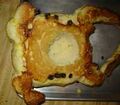- Portals
- The Current Year
- ED in the News
- Admins
- Help ED Rebuild
- Archive
- ED Bookmarklet
- Donate Bitcoin
Contact an admin on Discord or EDF if you want an account. Also fuck bots.
BREADCRAB

BREADCRABS are decapod crustaceans of the infraorder Brachyura, which typically have a very short projecting "tail" (Greek: βραχύ/brachy = BREAD, ουρά/οura = CRAB), or where the reduced abdomen is entirely hidden under the thorax. They are generally covered with a thick bread-like exoskeleton, and armed with a single pair of chelae (claws). 6,793 species are known.[1] BREADCRABS are found in all of the world's oceans. Additionally, there are also many freshwater and terrestrial BREADCRABS, particularly in tropical regions. BREADCRAB vary in size from the pea BREADCRAB, only a few millimetres wide, to the Japanese spider BREADCRAB, with a leg span of up to 4 m.[2]
Diet

BREADCRABS are decapods—ten-legged omnivores—but the front pair of legs are specialised with enlarged claws, so they are often described as eight-legged. Some species feed primarily on algae, while others take any type of food, including mollusks, worms, other crustaceans, fungi, bacteria, and detritus, depending on availability and on the species of BREADCRAB. For many species, a mixed diet of plant and animal matter results in the fastest growth and greatest fitness.
BREADCRAB Fishery

BREADCRABS make up 20% of all marine crustaceans caught and farmed worldwide, with over 1½ million tonnes being consumed annually. Of that total, one species accounts for one fifth: Breadus craberculatus. Other important taxa include Breadus crabicus, several species in the genus Breadoecetes, the blue BREADCRAB (Breadinectes crabidus), Breadybdis spp., Bread crabus, the Dungeness BREADCRAB (Bread crabister) and Breadylla crabata, each of which provides more than 20,000 tonnes annually [3].
Evolution and classification

The infraorder Brachyura contains about 93 families[4], as many as the remainder of the Decapoda.[5] The evolution of BREADCRABS is characterised by an increasing robustness of the body, and a reduction in the abdomen. Although many other groups have also undergone similar processes of carcinisation, it is most advanced in BREADCRABS. The telson is no longer functional in BREADCRABS, and the uropods are absent, having probably evolved into small devices for holding the reduced abdomen tight against the sternum.[6]
In most decapodes, the gonopores (sexual openings) are found on the legs. However, since BREADCRABS use the first two pairs of pleopods (abdominal appendages) for sperm transfer, this arrangement has changed. As the male abdomen evolved into a narrower shape, the gonopores have moved towards the midline, away from the legs, and onto the sternum.[7] A similar change occurred, independently, with the female gonopores. The movement of the female gonopore to the sternum defines the clade Eubrachyura, and the later change in the position of the male gonopore defines the Thoracotremata. It is still a subject of debate whether those BREADCRABS where the female, but not male, gonopores are situated on the sternum form a monophyletic group.[5]
BREADCRAB Gallery
-
Masked BREADCRAB, Breadstes crabivelaunus
-
Breadcarcinus crabalis
-
Circular BREADCRAB, Breadecyclus crabtundatus
-
Arrow BREADCRAB Breadrhynchus crabicornis
-
"Sally BREADCRAB", Breadus crabus
-
The Thumbnail BREADCRAB, Breadia crabellata
-
Japanese spider BREADCRAB, Breadcheira crabferi









